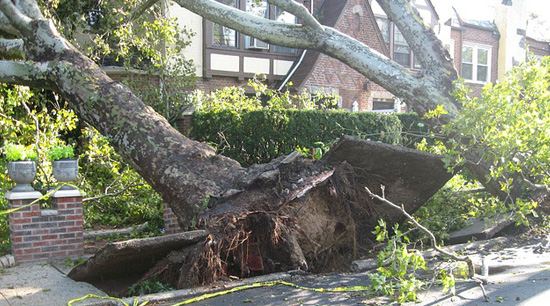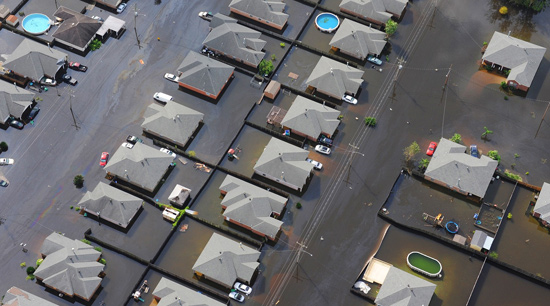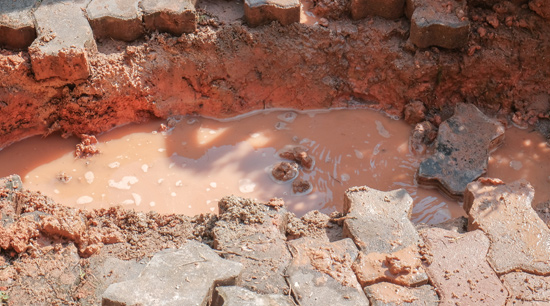Flood and water damage can result from natural disasters, trees with aggressive roots, faulty appliances, frozen pipes, and hundreds of other possibilities at any time and anywhere.

Within our businesses and homes, we thrive on and desire a sense of security. The security that everything is functioning well, and because we have kept up on regular maintenance, we expect that nothing will happen. That is until 3:00 a.m. one random Tuesday morning your neighbor’s 100ft oak tree comes crashing down on the guest bathroom.
The team at AWDR has had to respond to a wide variety of flooding scenarios alike and different than this. This article outlines 4 of which that are more common than you might want to believe.
1. A Tree Fell on My House
A tree falling on your home or business is probably the worst nightmare a property owner can have.

So, it’s 3:00 a.m. on a Tuesday morning and you wake up to the sound of a tree crashing through your roof, destroying your guest bathroom. By the time you gather your senses, the (now broken) plumbing has already begun to flood your home.
Priority number one is the safety of your family and pets. Once they are out of harm’s way, the following steps will help get the cleanup process under way:
- Turn off the water main at the street (See video below for help)
- Turn off the electricity
- Call a 24 Hour Emergency Tree Service
- Call a 24 Hour Emergency Water Removal Company
- Call your insurance company
- Take pictures of the tree, the roof, all physical damage, and the water in the house
Once the tree and flood water have been removed, structural damages will have to be addressed (and well documented). A vital component to getting things back in order is to have a certified plumber perform an inspection on the structure’s entire plumbing system.
According to 72 Tree of Alpharetta Ga, the impact of a tree falling on anything has the potential to be catastrophic. While things may appear normal on the other side of the house, the jolt from that impact could very well have caused further hidden damages.
Watch this video to see how a water main is shut off.
Note: The above suggestions are based on hypothetical tree emergency priorities. Be aware of the regulations and requirements of your insurance policy and provider. Avoid any action(s) considered to be in violation of and potentially voiding your insurance policy.
2. City Sewage Water Main Backed Up in Storm
Some hours after a major weather system began unloading its rain on your town, you notice that the water level is rising and that massive amounts of water are being ejected from the sewage drains.
There is a compounded issue happening. If the rain doesn’t stop, the water will continue to rise and flood your business. And because the city’s sewage main has either been obstructed or is over capacity, the water coming your way is “black water”. Black water is heavily contaminated water carrying pathogens, feces, and bacteria.

When the sewer main cannot evacuate water, there is a potential for that water to back up through your toilets and sink drains. Remember that this is black water and contact with it should be avoided at all costs.
From the moment you realize that the water will flood your business, immediate action should be taken to protect any valuable furniture or important documents. Get them to either a second floor, an elevated location, or remove them from the location.
Once you have taken measures to protect your valuables, turn off the power (short circuits can cause electrocution and fires), and evacuate. When flood waters carry raw sewage, the health impact can be catastrophic, and there is no safe amount of exposure.
When the storm subsides and the waters recede, the following should be done to get you up and running again:
- Photograph and document all damages
- Call a Water Removal Company certified to handle sewage cleanup and removal
- Call your insurance company
- Only return to the premises once it has been properly cleaned and professionally sanitized
Do not try to clean the premises on your own. In accordance with IICRC standards, the handling of sewage and its removal should only be performed by trained and experienced technicians equipped with full protective equipment.
Your cleanup team should consist of certified technicians that will have specialized equipment – air scrubbers and dehumidifiers – and are able to perform the cleanup according to IICRC industry standards.
Note: The above suggestions are based on hypothetical business flooding priorities. Be aware of the regulations and requirements of your insurance policy and provider. Avoid any action(s) considered to be in violation of and potentially voiding your insurance policy.
3. Tree Roots Broke the Water Main
One summer afternoon you arrive home from work and make your way to the bathroom to take a cool shower and wind down. As you turn the water on, it spits and sputters only producing a trickle coming from the shower head.
After verifying that all of the water connections, valves, and water heater are working fine, you go to the basement only to step in a pool of water! So, you head to the sidewalk to shut off the main connection. That’s when you realize that your front yard is completely saturated.

The culprit in this scenario is the underground, ruptured water main.
The tree you planted some years ago in the center of the yard grew, and its roots spread in search of moisture and fertile soil.
Because the tree was planted so close to the water main, the roots grew along side and around it. Over time, those roots thickened and applied continuously increasing pressure until the water main cracked.
Consider this, the average residential water main is a 1 inch pipe from the street to your home. A ruptured 1 inch pipe can evacuate more than 200 gallons of water per minute. That’s more than 12,000 gallons of water per hour. You have a serious water emergency on your hands.
Immediate action is required in situations like these. Not only do you have a flood happening in your basement, your tree could potentially become unstable and fall due to the extreme soil saturation. The following steps will help you get things back in order.
- While there is water pooled in your basement, shut off the electricity to avoid shock or electrocution.
- Take pictures and document all affected areas
- Call a professional Water Removal and Remediation Company
- Call a professional Tree Service to evaluate the stability of the tree
- Call a professional Plumber to fix the water main
- Call your insurance company
In a situation like this, it is imperative to not only fix the water main, remove the water, and properly dry and sanitize the basement, but also to make certain that the tree itself is safe or that it should be removed.
The following video shows how to detect and locate a water leak.
Note: The above suggestions are based on a hypothetical broken water main situation. Be aware of the regulations and requirements of your insurance policy and provider. Avoid any action(s) considered to be in violation of and potentially voiding your insurance policy.
4. Washing Machine Water Supply Hose Burst
After taking your family out for a Saturday at the park, lunch, and movie, you return home ready to enjoy the rest of your day off. You open the door, step inside and “squish” you’re stepping onto a soaked carpet!
After turning off the power (to avoid shock or electrocution), you follow the hissing noise to the washing machine. While you were out, the hot water supply hose ruptured, has been spewing water freely, and has flooded your home.
Once you’ve shut the water off, it’s time to take action. The longer the water sits, the more damage it will do to furniture, flooring, baseboards, and drywall. Taking the following steps will help you get things back to normal:
- Take pictures and document all affected areas
- Call a professional Water Removal Company
- Call a professional Plumber to inspect all appliances with water connections
- Call your insurance company
In a scenario such as this, your home must be professionally dried and sanitized. With that much moisture involved, improper drying could result in the growth of mold and mildew.
In many cases, for your insurance to cover damages, they will require that a full service water remediation company be contracted to handle the removal, cleanup, and damage repair work.
For prevention purposes, water hoses and their connections to your appliances should be checked at least twice per year. When cracking or hardening of the hoses is detected, they should be replaced.
Learn how to change washing machine water supply hoses in this video.
Note: The above suggestions are based on a hypothetical appliance malfunction. Be aware of the regulations and requirements of your insurance policy and provider. Avoid any action(s) considered to be in violation of and potentially voiding your insurance policy.
Insurance, Water Removal, Tree Service, and Prevention
Whether for your home or business, it is vital to keep your insurance policies up-to-date. When disaster comes by way of flood or falling tree, professional water companies and tree services will work directly with your insurance company to ensure that you are getting the maximum benefits of your insurance policy.
Prevention is worth the time and effort. If you don’t already have a maintenance schedule, create one. Make certain that annual inspections such as plumbing, appliances, and trees are on that schedule.
Have a plan. In the event of an emergency, being prepared will save time and money. Know who to call and the valuables to take if you have to leave the property. The ultimate goal is to keep your family or coworkers safe, while lessening the damage that is done to your property.
(678) 505-0266